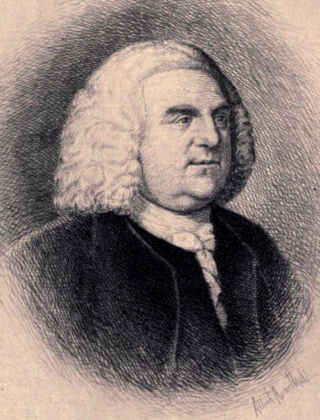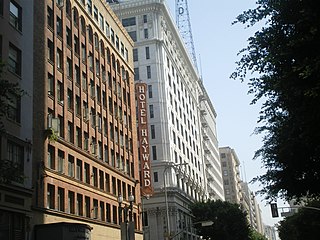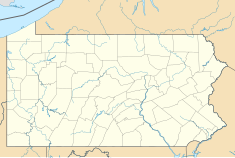
Allentown is the county seat of Lehigh County, Pennsylvania, United States. It is the third-most populous city in Pennsylvania with a population of 125,845 as of the 2020 census and the most populous city in the Lehigh Valley metropolitan area, which had a population of 861,899 and was the 68th-most populous metropolitan area in the nation as of 2020.

William Allen was a wealthy merchant, attorney and chief justice of the Province of Pennsylvania, and mayor of Philadelphia during the colonial era. At the time of the American Revolution, Allen was one of the wealthiest and most powerful men in Philadelphia. A Loyalist, Allen agreed that the colonies should seek to redress their grievances with British Parliament through constitutional means, and he disapproved of the movement toward independence.

Hess's, originally known as Hess Brothers, was a department store chain based in Allentown, Pennsylvania. The company was founded a single store in 1897, and grew to nearly 80 stores by its commercial peak in the late 1980s. The chains stores were closed or sold off in a series of deals in the early to mid-1990s.

William Allen High School, often referred to as Allen High School or simply Allen, is one of two large, urban public high schools of the Allentown School District in Allentown, Pennsylvania. The school provides public education for grades 9 through 12. William Allen High School is located at 106 N. 17th Street in Allentown. It serves students from center city and the city's westside. The city's other public high school, Dieruff High School, serves students from Allentown's eastern and southern sections. Until Dieruff's opening in 1959, William Allen High School was known as Allentown High School.

Miller Symphony Hall is a 1,100-seat performing arts facility in Allentown, Pennsylvania that hosts the Allentown Symphony Orchestra. The hall was previously known as Central Market (1896), Lyric Theater (1899), and Allentown Symphony Hall (1959). In 2012, it was renamed for the Miller family, longtime owners of the hall and of The Morning Call newspaper.

Spring Street in Los Angeles is one of the oldest streets in the city. Along Spring Street in Downtown Los Angeles, from just north of Fourth Street to just south of Seventh Street is the NRHP-listed Spring Street Financial District, nicknamed Wall Street of the West, lined with Beaux Arts buildings and currently experiencing gentrification. This section forms part of the Historic Core district of Downtown, together with portions of Hill, Broadway, Main and Los Angeles streets.

Hamilton Street is a major thoroughfare and historic street in the Center City section of Allentown, Pennsylvania. The street dates back to 1762, when Allentown's founder, William Allen, included it as one of the first of several streets to be constructed in the city.

The buildings and architecture of Allentown, Pennsylvania reflect the city's history from its founding in 1762 through to the present.

Center City Allentown is the downtown and central business district of Allentown, Pennsylvania, the third-largest city in the U.S. state of Pennsylvania. It has a dense population and is currently undergoing an urban revitalization process.

H. Leh & Co., typically referred to simply as Leh's, was a department store located at 626 West Hamilton Street in Allentown, Pennsylvania. It was of what was an outside mall structure called the Hamilton Mall in the Center City portion of the city. Like many other downtown department stores of the time, however, it ultimately closed as suburban shopping malls gained market share at the expense of inner-city stores.

Schoenersville is a suburban village split between Hanover Township in Lehigh County and Hanover Township in Northampton County, Pennsylvania. It is pronounced "SHOO-nerz-vil" and is part of the Lehigh Valley metropolitan area, which has a population of 861,899 and is the 68th-most populous metropolitan area in the U.S. as of the 2020 census.

Americus Hotel is a historic hotel in Allentown, Pennsylvania. Built between 1926 and 1927, it is a 13-story yellow brick building located 541 West Hamilton Street in Center City Allentown.

The Dime Savings and Trust Company, also known as the First Valley Bank, is an historic bank building located in Allentown, Pennsylvania. It was built in 1925, and is a T-shaped, five-story red brick building.

The Allentown National Bank, originally named the Allentown Bank, is an historic bank building located on Centre Square in Allentown, Lehigh County, Pennsylvania. Built in 1905, the building is a large eight-story, steel frame and masonry-clad structure in the Beaux-Arts style.

The Zollinger-Harned Company Building, now known as The Sovereign Building, is a historic department store building on Hamilton Street in the Center City section of Allentown, Pennsylvania.

The Colonial Theater was a former cinema and stage theater in Allentown, Pennsylvania, United States. Opened in 1920, for over 50 years it was considered the glamour cinema in the central business district. It closed in 1982, and was torn down in 2005 after years of being vacant and deteriorated. The site has been redeveloped as Three City Center, part of the Allentown Neighborhood Improvement Zone (NIZ).
The Allen Theater is a former cinema in Allentown, Pennsylvania. It opened in 1915 and closed in 1989.

The Farr Building is a historic office building in Allentown, Pennsylvania. The building, which opened in 1907, is currently used as retail and residential space.

Allentown station is a defunct train station in Allentown, Pennsylvania. It was constructed by the Central Railroad of New Jersey (CNJ) and Reading Railroad in 1888 and 1889. For most of the late 19th and early 20th century, it provided passenger train service between Allentown and various U.S. Coast locations.






















